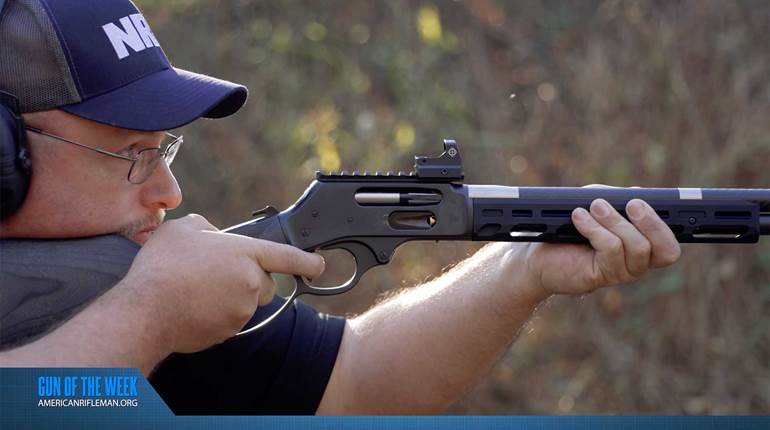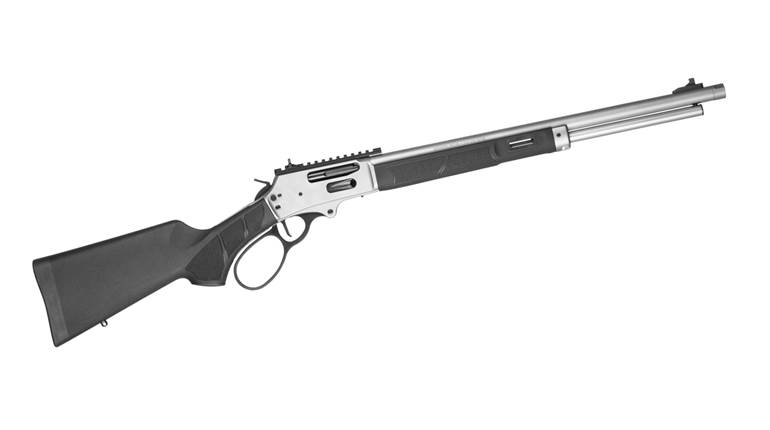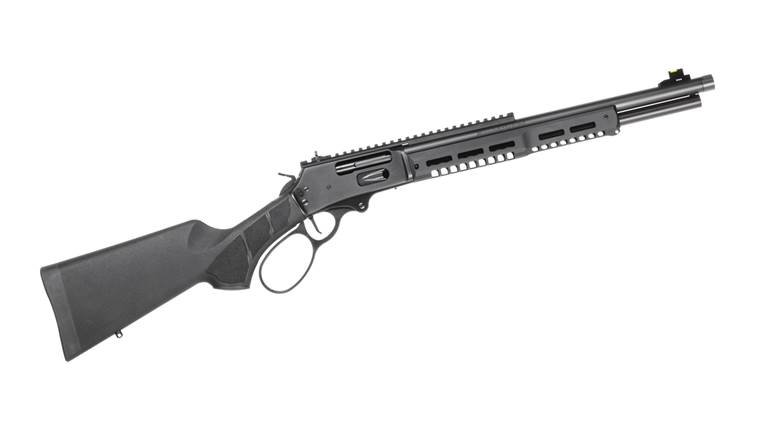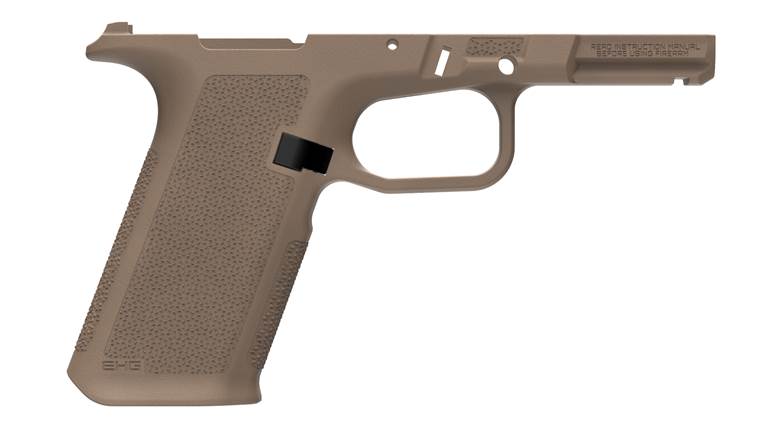
This feature article appeared originally in the November 2014 issue of American Rifleman. To subscribe to the magazine, visit the NRA membership page and select American Rifleman as your member magazine.
In his 1895 poem entitled “The Young British Soldier,” Rudyard Kipling cautions the new recruit against blaming his rifle for his own poor marksmanship, and mentions the name of the longarm that secured the British Empire of the Victorian period:
“When ’arf of your bullets fly wide in the ditch, Don’t call your Martini a cross-eyed old bitch; She’s human as you are—you treat her as sich, An’ she’ll fight for the young British soldier.”
The Martini rifle truly is a world icon, and is recognizable across most of the globe. Along with the steamship and the railroad engine, it was responsible for “painting the map of the world red” for the British Empire during the latter part of the 19th century. Although it was primarily a 19th century arm, varieties of the Martini-Henry rifle were seen in conflicts worldwide, from the late 1870s into the mid-20th century.
Even as recently as 2011, several rifles that had been captured from British troops by Afghan forces at the 1880 battle of Maiwand were discovered by British NATO soldiers in a Taliban arms cache, and at least one rifle was captured by U.S. Marines in 2010 from a similar stockpile. Highly decorated examples of the rifle are carried today as a mark of pride in Oman, and they can still be found in shops in other countries throughout the Middle East.
Among the general populace and military history “buffs,” however, the Martini-Henry is mostly recognized today through the movies that have featured its use on far-flung battlefields. Most widely known by its prominent role in the 1964 movie “Zulu,” it also appeared in subsequent movies such as “Zulu Dawn,” “The Man Who Would Be King,” “The Ghost And The Darkness,” the 2002 remake of “Four Feathers” and, most recently, in a film about Sherlock Holmes that debuted in 2009. Among firearm enthusiasts and shooters, the Martini is well known because of its strong, simple and reliable action. Its robust receiver can accommodate very high chamber pressures, and although the recoil can be significant, it is enjoyable and fun to shoot.
 Most Americans became aware of the Martini-Henry rifle in the 1960s after seeing the movie “Zulu,” which featured the 24th Foot, also known as the South Wales Borderers. Nonetheless, the arm served throughout the British colonial campaigns of the 19th Century in the hands of many other famed regiments, such as the Royal Irish Fusiliers. Painting by Godfrey Douglas Giles.
Most Americans became aware of the Martini-Henry rifle in the 1960s after seeing the movie “Zulu,” which featured the 24th Foot, also known as the South Wales Borderers. Nonetheless, the arm served throughout the British colonial campaigns of the 19th Century in the hands of many other famed regiments, such as the Royal Irish Fusiliers. Painting by Godfrey Douglas Giles.
When the British government adopted the Martini- Henry system in 1871, it was standardizing a simplified version of a rifle that had been invented in the early days of the American Civil War. Henry O. Peabody, a middle-aged New England inventor, patented a breech-loading carbine in 1862 and sold his patent rights to the Providence Tool Co. of Providence, R.I., two years later. The firearm was singularly uncomplicated. The breechblock was enclosed in a steel frame and was pivoted at the rear. To load, a soldier simply had to shove the trigger guard forward and, by means of an internal lever acting as a fulcrum, the forward end of the breechblock tilted down in the receiver, thus exposing the chamber. The soldier then slid the primed and self-contained .44-40-60 rimfire cartridge into the grooved top of the breechblock and into the chamber. Pulling back on the trigger guard raised the front of the breechblock, thus sealing the cartridge in the chamber. The side hammer was then withdrawn to full cock, and the rifle was ready for firing.
The U.S. government did not adopt the Peabody system during the American Civil War, although it was a strong and reliable breechloader. Before and after buying the patent from Peabody, the Providence Tool Co. had supplied 60,000 .58-cal. muzzleloading rifle-muskets to the Union cause, so the arm was well known to the War Dept. At the end of the war, the Peabody design came in first during trials that were staged to determine which breechloader would replace the muzzleloading rifle-musket. However, since Erskine Allin’s “trapdoor” breechloading system could readily be adapted to the existing stockpile of muzzleloading shoulder arms, the Springfield “Trapdoor,” and not the Peabody, became the American standard for the following 26 years. Allin was the Master Armorer at the National Armory in Springfield, Mass., and that also certainly carried some weight.
 Beyond their use in Africa and other foreign campaigns (l.), Martini-Henry, Martini-Metford and Martini-Enfield rifles were used by both sides in Home Rule-related conflicts in Northern Ireland during the years leading up to World War I. Carbines, such as this example, were often preferred by the Ulster Volunteer Force because their shorter barrels made them easier to smuggle. Zulu warrior c. 1879; illustration courtesy of Donna J. Neary; rifle courtesy of Gareth Armstrong.
Beyond their use in Africa and other foreign campaigns (l.), Martini-Henry, Martini-Metford and Martini-Enfield rifles were used by both sides in Home Rule-related conflicts in Northern Ireland during the years leading up to World War I. Carbines, such as this example, were often preferred by the Ulster Volunteer Force because their shorter barrels made them easier to smuggle. Zulu warrior c. 1879; illustration courtesy of Donna J. Neary; rifle courtesy of Gareth Armstrong.
The Providence Tool firm actively sought foreign contracts, but was in competition with other American firms, such as Remington (with its very successful “rolling block” action) and Winchester. The firm’s first contract was with Canada, and some units of the Canadian militia used their .50-60-cal. Peabody rifles to repel incursions by Irish-American “Fenians,” who were bent on seizing Canada and holding it hostage in exchange for Ireland’s freedom from Britain. Switzerland and Romania then followed suit, with the Swiss rifles and carbines chambered in 10.4 mm (.41 Swiss rimfire), while the Romanians fired an 11.4 mm cartridge. In the following years, the Peabody system was also used by Spain, in both .50 Spencer and .43 Spanish, while Mexico bought 8,000 rifles in .43 Spanish. The French government also purchased 33,000 rifles in the same chambering during the 1870 Franco-Prussian War. Several American states—Connecticut, Massachusetts, and South Carolina—issued Peabody rifles to their respective militias in the 1870s, and Connecticut even returned their rifles to the company to have them re-barreled for the standard .45-70 Gov’t cartridge.
In 1866, a Swiss inventor named Friedrich von Martini simplified the basic Peabody action by eliminating the large outside hammer and replacing it with a spring-loaded internal striker—or firing pin—that cocked when the action was opened. In place of the external hammer, the inventor added a teardrop-shaped indicator that showed whether or not it was cocked. He also enlarged the trigger guard by adding a tailpiece that gave the soldier a better and more positive action when cocking the rifle and extracting the spent cartridge. Martini freely admitted that he had based his design on the Peabody action, and the Providence Tool Co. even produced hammerless “Peabody-Martinis” for sale to Turkey and Peru. The Turkish rifles became famous for their effectiveness at the battle of Plevna in 1878. (Interestingly, the Turkish soldiers, who were armed with American lever-action Winchester repeating rifles and single-shot Peabody-Martini rifles, faced, among others, Romanians armed with Peabody rifles.)
 Peabody rifle courtesy of National Museum of the Marine Corps; photo by Iain S. Ross.
Peabody rifle courtesy of National Museum of the Marine Corps; photo by Iain S. Ross.
Meanwhile, the British government was searching for a design to replace its .577-cal. Snider breechloaders. The Snider action, an American invention, was the means by which the British had converted its arsenal of muzzleloading Enfield rifle-muskets and carbines to breechloaders, starting in 1866. The British Army was seeking a rifle with better accuracy at longer ranges, as well as a higher-velocity cartridge. A solution was found when the strong, simple and robust Martini action was coupled with the incredibly accurate rifling system invented by a Scotsman, Alexander Henry. The resulting rifle was named the Martini-Henry, and it was adopted as the standard British shoulder arm in 1871.
The Martini-Henry was chambered for the .577/.450 bottle-necked cartridge, with its case made of thin rolled sheets of brass and attached to an iron base. The cartridge featured a centerfire primer system that had been invented by an Englishman, Col. Edward M. Boxer, then the director of the Woolwich Arsenal, near London. Although Boxer had designed the coiled brass case so it could expand and then contract in the chamber, it proved to be too fragile for field service and was later replaced with a drawn brass cartridge. The .45-cal. bullet weighed in at 480 grains and was made of an alloy consisting of 12 parts lead to one part tin. It was propelled by 85 grains of No. 2 fine rifle blackpowder, and left the muzzle at a velocity of approximately 1,300 f.p.s.
This new rifle operated much the same as its predecessor, the Peabody. Holding the rifle horizontally at the balance point with his left hand, the soldier used his right hand to push down the rear tail of the trigger guard, which, on the British Martini, had developed into much more of a lever than on the Peabody. The action tilted the forward end of the internal breechblock down, both exposing the breech and cocking the rifle. The soldier withdrew a cartridge from his belt-mounted ammunition pouch and slid it into the open breech. Pulling up on the rear lever closed the breech. It was then ready for firing. Although the initial model had been designed with a safety catch, most of the future versions dispensed with that feature.
 A bayonet charge by British forces, including the Queen’s Own Cameron Highlanders, broke the back of the Egyptian defenses at Tel-el-Kebir in the 1882 Egyptian campaign. However, succeeding volleys of Martini-Henry rifle fire pulverized the Egyptian troops, resulting in a lopsided victory for the British. Painting by Frank Teller.
A bayonet charge by British forces, including the Queen’s Own Cameron Highlanders, broke the back of the Egyptian defenses at Tel-el-Kebir in the 1882 Egyptian campaign. However, succeeding volleys of Martini-Henry rifle fire pulverized the Egyptian troops, resulting in a lopsided victory for the British. Painting by Frank Teller.
Although the new rifle was approved in 1871, the troops fighting in the 1873-74 Ashanti War in West Africa were still armed with the Snider Enfield, and were not issued Martini-Henry rifles until their return to England. However, in addition to the standard socket bayonets, they also carried Pattern 1870 Elcho bayonets and “yataghan”-bladed sword bayonets, both of which were later altered to fit the Martini-Henry rifles and carbines. The next of “Queen Victoria’s little wars,” the “Zulu War” or, as it was officially known, the South African Campaign of 1879, was to brand the Martini-Henry indelibly in the consciousness of the world. The embarrassing defeat of the battle of Isandhlwana, where the inability of the soldiers to break open their wooden crates of rifle ammunition played a critical role, and the memorable and valorous defense of Rorke’s Drift, ensured that the world would recognize and remember the Martini-Henry. The simultaneous campaign in which the Martini-Henry played the major role was the Afghan Campaign of 1878-1880. Although ultimately successful, the British Army suffered several setbacks at the hands of Afghan tribesmen, who were mostly armed with long flintlock and caplock jezhail rifles.
During the next year, the British forces, that were continuing the decades-long on and off struggle between the Boers and the British imperialists in South Africa, were armed with the Martini-Henry when they were decisively defeated at the battle of Majuba Hill in 1881. However, it was in Egypt and the Sudan where the Martini-Henry next really proved its worth. In the hands of seasoned British regulars in such battles as Tel-el-Kebir and Abu Klea, the rifle proved again and again that accurate fire by disciplined troops using a rifle with a simple and robust action (and backed up with a socket-mounted, triangular bayonet) counted more than simply having an overwhelming preponderance of fighting men on the battlefield. As more Martini-Henrys became available, they were issued to Indian and other native troops from the colonies and the empire to replace their Sniders.
Problems with ammunition and spent cartridge extraction were responsible for the major, and most apparent, changes in the appearance of the rifle while in British service. To be sure, numerous minor improvements had been made shortly after the rifle’s debut in 1871 and more changes continued for several decades, but the difficulty of extracting empty shell cases in some circumstances led the designers to incorporate a much longer loading lever on the “Mark IV” version that emerged in the mid-1880s. At about the same time, the rear of the receiver was also enlarged, and a few other minor improvements were affected.
 Romania adopted the Peabody rifle, and her troops used it at the battle of Plevna in 1878. Some of the opposing Turkish troops were armed with the hammerless Martini-Peabody rifle. Statue courtesy of Romanian National Gallery of Art; photo by Iain S. Ross.
Romania adopted the Peabody rifle, and her troops used it at the battle of Plevna in 1878. Some of the opposing Turkish troops were armed with the hammerless Martini-Peabody rifle. Statue courtesy of Romanian National Gallery of Art; photo by Iain S. Ross.
In the midst of those changes, the government elected to reduce the bullet diameter. Wiser heads prevailed, but not without the cost of retrofitting thousands of rifles already manufactured for the new and short-lived .402 cartridge. It must be remembered that the British Army was in the process of adopting the bolt-action, magazine-fed .303 Lee rifle for its first-line troops at that time, and the anticipated logistical nightmare of three different types of rifle ammunition (not to mention carbine and machine gun ammunition, plus the fact that many native troops were still armed with .577 Sniders) would have resulted in disastrous consequences during active service in a distant campaign.
By 1890, the Martini-Henry was seen throughout Africa, Asia, Australia and, of course, in the British Isles. It went wherever the British Union Jack flew. There were rifles, cavalry carbines, artillery carbines, cadet carbines and smoothbores for police and prison guards. It was conspicuously absent, however, in the Americas and the Western Hemisphere. Except in a very few cases, the Canadian militia progressed directly from the Snider to the Long Lee-Enfield and Ross rifle, while in both Central and South America, most of those countries favored the American Ryder-designed Remington Rolling Block rifle, and, for the most part, they transitioned straight from those single-shot rifles to the German bolt-action Mauser repeating rifle. As noted earlier, U.S. troops were issued the “Trapdoor” Springfield.
With the adoption of the bolt-action Lee-Metford repeating rifle in 1888, the British abandoned the .577/.450 cartridge for the new high-velocity .303 round. Shortly afterward, it was decided to convert many of the Martini-Henrys on hand to the new cartridge, and the resulting design was termed the “Martini-Metford.” By the mid-1890s, when the British were moving from blackpowder to smokeless cordite for the propellant in their .303 cartridges (and thus necessitating the change from the Metford shallow-groove rifling system to the more modern Enfield rifling system), existing stocks of Martini-Henrys, both rifles and carbines, were being converted into .303 “Martini-Enfields.” Some of those Martini-Enfield carbines saw service during the Second Anglo-Boer War of 1899-1902, mostly in the hands of Dominion troops—Australians, New Zealanders and Canadians. A number of the rifles were issued to colonial native troops.

Of course, Martini-type firearms were also being produced by firms for the commercial market, as well as under government contract. Most of those non-government manufacturers, such as Westley-Richards, Greener and Birmingham Small Arms, were British, but Martinis were also being produced under license in Belgium and as far away as at government arsenals in Nepal. In fact, the Nepalese produced an indigenous improved version of the Martini, known as the Gahendra. Martini-type arms in various calibers were produced as well by individual artisans in the Khyber Pass between Afghanistan and modern-day Pakistan, and some are coming back to the United States today as souvenirs acquired by American military personnel serving in Afghanistan.
The sale of commercial varieties of the Martini family of arms to foreign countries prompted two of the most curious stories about these firearms. When the independent South African Boer republic of the Transvaal began to re-arm during the 1890s in the face of a renewed threat from Great Britain, the country not only acquired surplus British Army arms, but also contracted for a special order of rifles from the British firm of Westley Richards. About 10,000 of those rifles were produced in Belgium and were sent to South Africa. They were marked “Specially Made for the ZAR” (Zuid Afrikaan Republik). Since they were of an improved design—the Francotte, that allowed the firing mechanism to be removed in one piece, like the Gahendra—the cocking lever on the side of the receiver is missing. The surplus British Martinis supplied to the Boers were simply stamped with a crude “Z.A.R.” followed by a number, and were sold by the Transvaal government to the Boer burghers for the price of four pounds each.
 Many variants of the Martini-Henry were made by various manufacturers, including the Nepalese Gehendra (top), which was built on the Westley Richards pattern. It is shown with a standard “short lever” Martini.
Many variants of the Martini-Henry were made by various manufacturers, including the Nepalese Gehendra (top), which was built on the Westley Richards pattern. It is shown with a standard “short lever” Martini.
One of the most interesting stories about the use of Martinis was their acquisition by both sides of the Home Rule question in Ireland in the years just preceding World War I. Both the Ulster Volunteer Force, which was sworn to oppose Home Rule in Ireland, even if it meant fighting the British Army, and the Irish Volunteers, who were sworn to enforce Home Rule when it became a reality, acquired numbers of Martinis of all varieties, in addition to Mausers, Mannlichers and Italian Vetterlis, in preparation for the anticipated fight. The absence of any markings on some of those Martinis was one of their hallmarks, as the suppliers did not want to have them traced back to their firms and, thus, many of them removed all markings while the arms were refurbished. Exact numbers and types of these firearms are speculative since both sides were illegally smuggling guns into Ireland, and extant records are scant. Nonetheless, photographic evidence shows numbers of Martini carbines (they were short and, therefore, easier to smuggle) being carried by the Ulster Volunteers, and there are accounts and photographs of Martini-type rifles and carbines being used by a few of the Irish Volunteers during the 1916 Easter Rebellion in Dublin.
After that period, Martini rifles and carbines were in evidence during the fighting in the Mid-East and India in the years leading up to World War II. As noted earlier, Taliban insurgents are still using it, albeit to a very minor degree. An active service life of more than 140 years would likely qualify any firearm as a monumental icon, but that is all the more true of one so well-known through such famous events in world history as the Martini-Henry.
 Image courtesy of author.
Image courtesy of author.
This article is based largely on a paper that was presented at the 2012 annual conference of the Int’l Committee of Museums and Collections of Arms and Military History that was held in the Sultanate of Oman. The author thanks Dr. Christopher Roads (former Assistant Director, Imperial War Museum) for encouraging him to produce the illustrated paper, and Guy Wilson (retired Keeper, Royal Armouries) for presenting it at the conference.





































